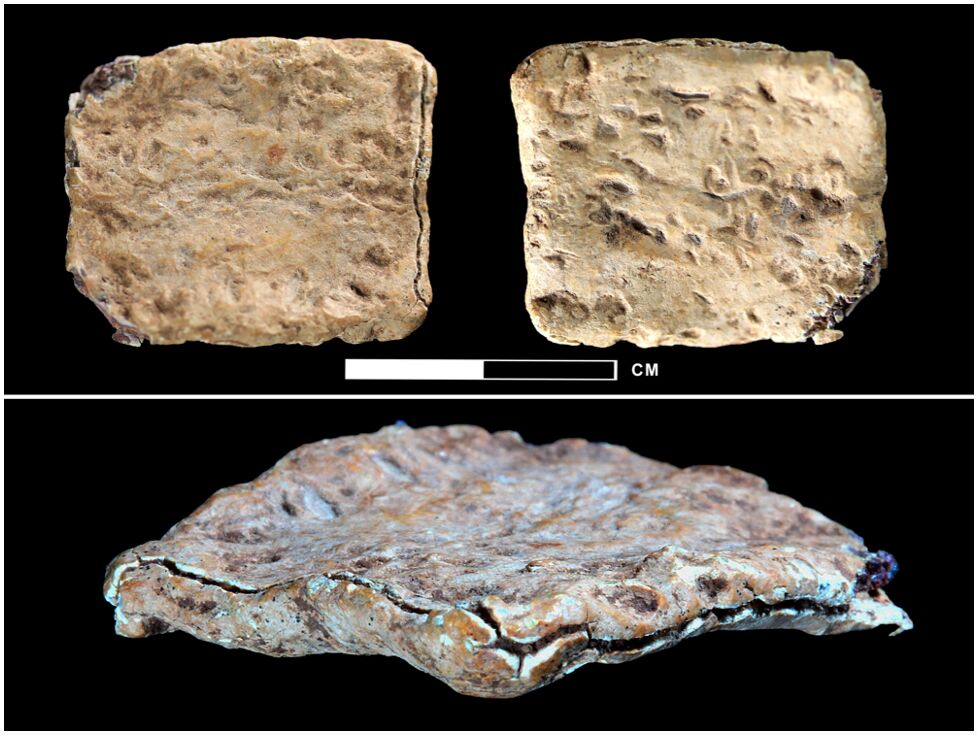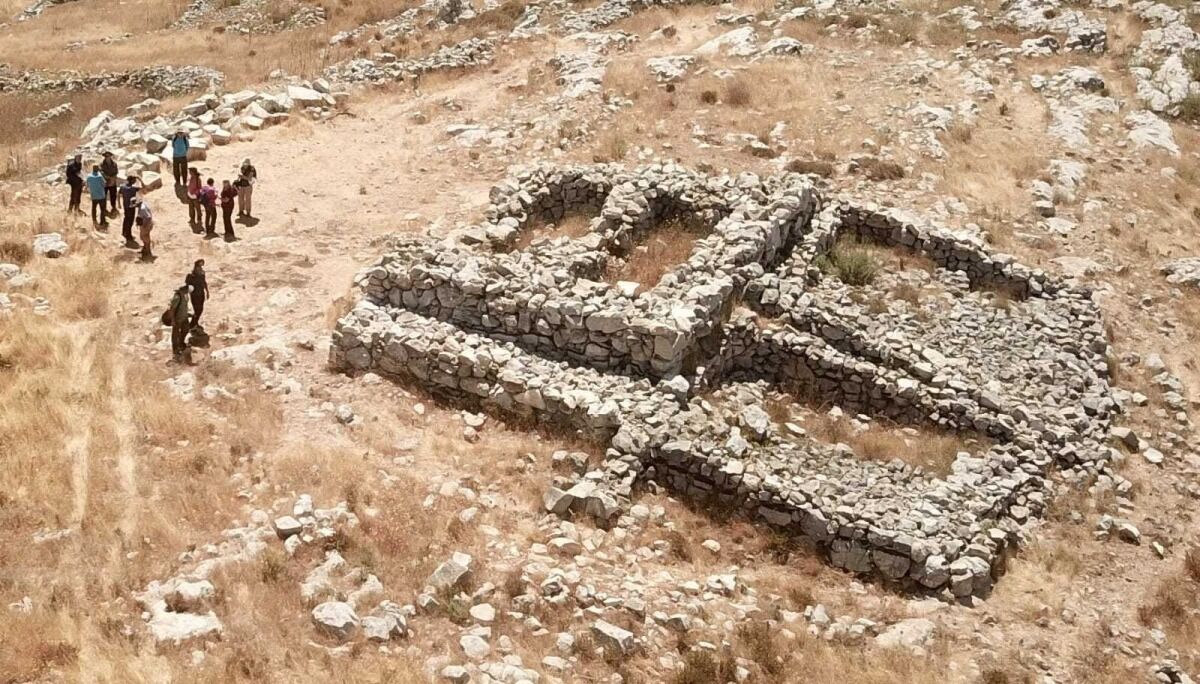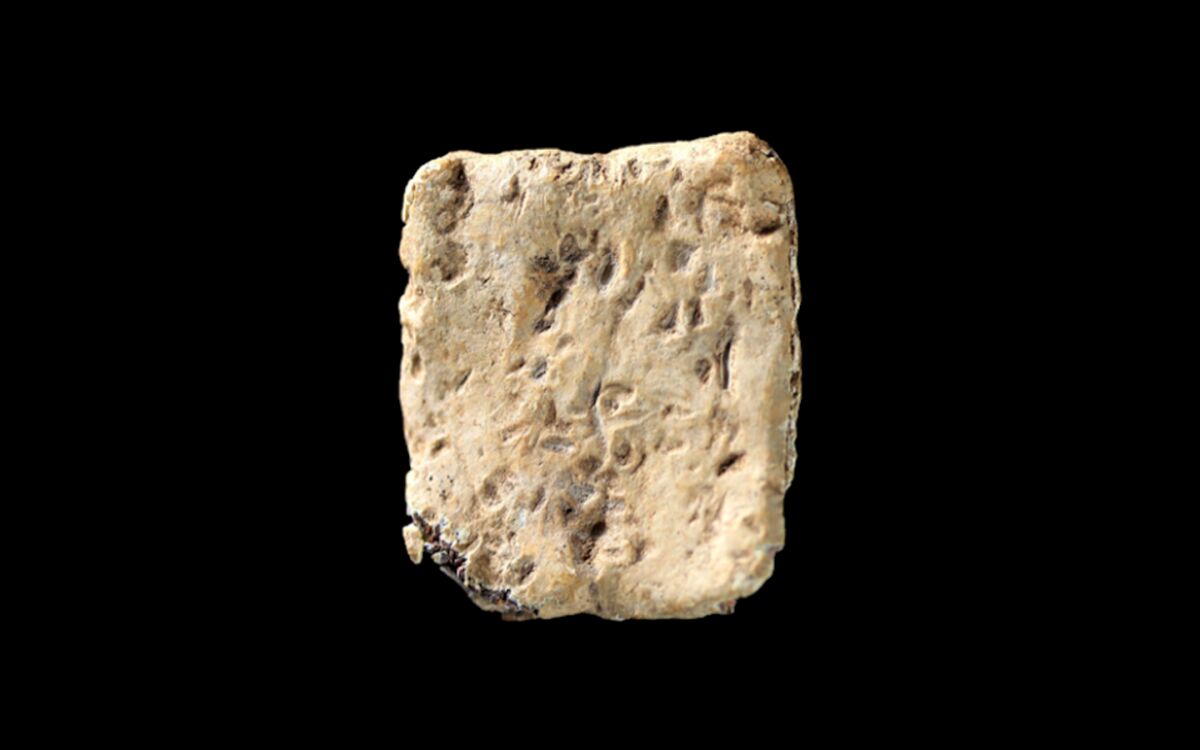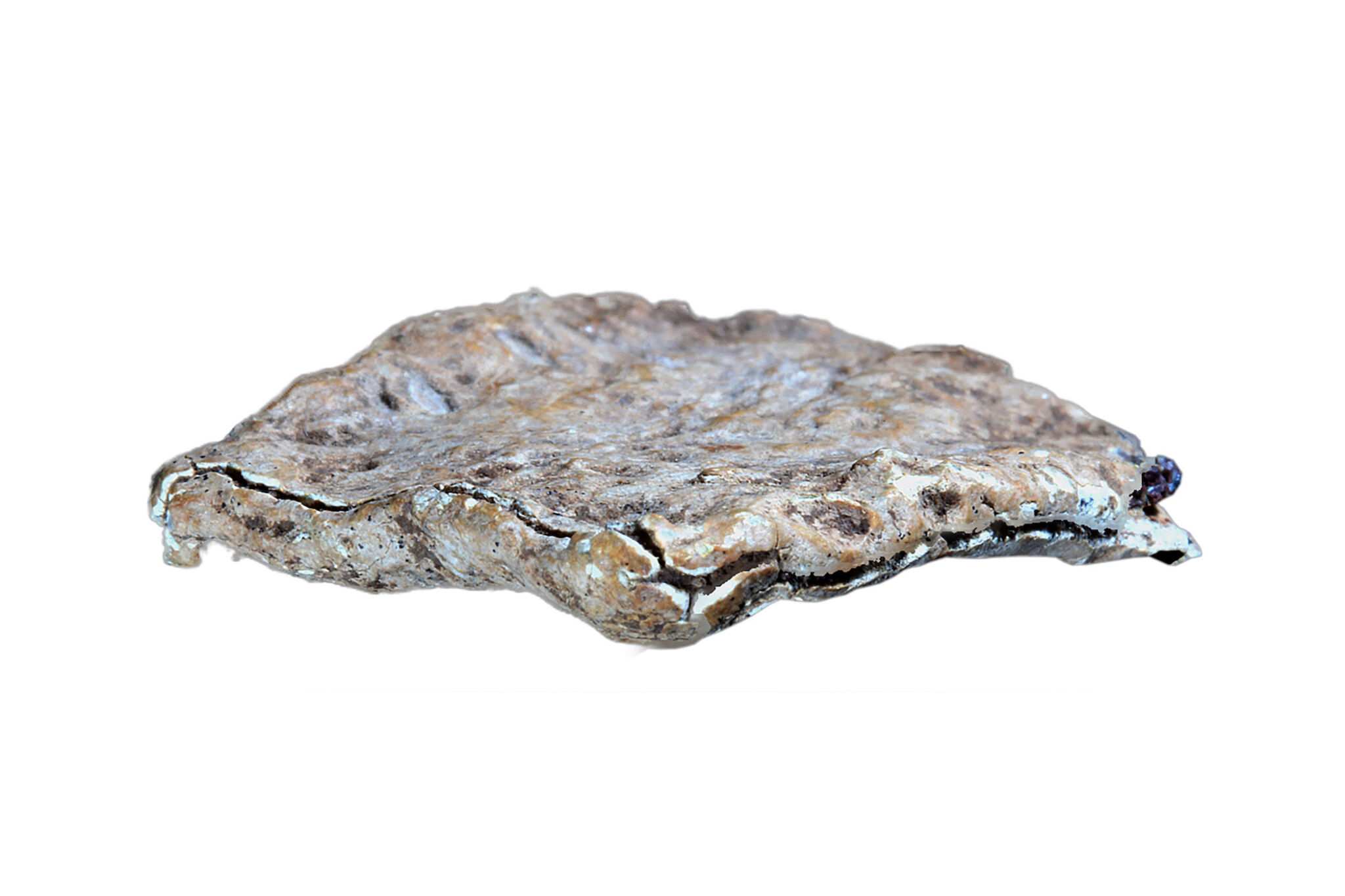The much anticipated Mount Ebal “curse tablet” was finally published last Friday, May 12, in the open-access peer-reviewed journal Heritage Science (read the article here). The miniature folded lead tablet, having been initially presented in a lively press release just over a year ago, had generated a huge amount of interest.

The defixio, or “curse tablet,” was discovered in 2019 by Dr. Scott Stripling’s team while they were sifting the excavation dumps of the “Joshua’s altar” site at Mount Ebal. The discovery quickly made headlines around the world—small wonder, given the very identification of the site as the “mount of cursing” described in the biblical account (Deuteronomy 11, 27, and Joshua 8), the proximity of the find to a structure identified as “Joshua’s altar,” and the dating of the artifact to this very time frame in early Israel’s history (more on this further down).
Along with the discovery of the artifact, a preliminary deciphering of the text contained within was announced at the press release last year. The folded, delicate nature of the tablet had made it too risky for the researchers to try to open it (after a failed test of malleability resulted in one of the corners breaking off); as such, tomographic scans were performed in order to try to “see” the text contained within. A formulaic inscription was presented to the public, reading as follows:
Cursed, cursed, cursed—cursed by the God yhw
You will die cursed
Cursed you will surely die
Cursed by yhw—cursed, cursed, cursed.
The press release generated a great deal of excitement—and controversy. This was, of course, primarily due to the magnitude of the conclusions, against the backdrop of not having first been presented in a peer-reviewed journal (a reason for this is noted in the above-linked article)—and also, due to a lack of imagery of the actual inscription text provided at the press release.
Nonetheless, we highlighted the sentiment at the time of expert epigrapher Dr. Haggai Misgav, who wrote on Facebook (translated from Hebrew): “I haven’t seen pictures of the find …. Whatever I don’t see with my own eyes—as a researcher—I don’t have anything to say. Nothing about the find, nothing about the reading, nothing about its interpretation. Research requires responsibility; not to assert what is uncertain, certainly not to say what you don’t know, and not to come out immediately in dismissal.”
Well, it’s finally arrived—at least, the interpretation of part of the four-sided inscription (the inner part—a future publication of the outer inscription is promised in the article). The article contains a significant amount of especially interesting and critical information relating to the find’s context, as well as methodology in attempting to digitally “unwrap” and read this otherwise closed lead tablet.
Naturally, most of the anticipation for the peer-reviewed article built up around the exact content of the inscription. But unfortunately, rather than the imagery presented clearing up much of the doubt and confusion, just the opposite appears to be the case. Since publication, there have been a range of reactions to the interpretation of the tablet’s content. From Prof. Douglas Petrovich expressing his support for one of the lead epigraphers (who, according to the paper, “deciphered most of the interior letters”):
To Dr. Peter Williams’s cautious optimism about the interpretation:
To Dr. Yonatan Adler’s less-than-veiled suspicion:
To Dr. Gad Barnea’s accusations of “outright deception” and push for retraction from the journal:
If you haven’t yet read the peer-reviewed article, I’d encourage you to do so. Central to this reaction is the highly interpretive, apparently garbled spread of text. It’s not what perhaps most may have expected—a simple text reading dextrograde (left-right), sinistrograde (right-left), boustrophedon (alternating “as the ox plows”), or even up or down—rather, a general discombobulation of letters of different sizes, orientations and shapes, spread over the tablet. To this end, where some see letters, others don’t see them at all (or at least, not anywhere near the totality presented), instead seeing cracks or fissures in the lead tablet.
Of course, examination via scanning of the interior of a folded and deformed tablet (lead, no less!) has its limitations, as Dr. Williams sympathizes:
Not to mention the tiny size of the artifact, and thus the difficulty in engraving much of anything of great substance or precision within.
It has been interesting to see the differences of opinion expressed among the contributors. As one of the epigraphers who authored the article, Dr. Peter van der Veen, commented recently on Facebook: “[W]e were several scholars within the team, scholars with different opinions seeking to meet in the middle in terms of dating questions, the direction of writing, let alone the identity of some of the lesser well detectable letters found in the inner central fold. While I was much more concerned about the reading of some letters, others were less. …
[I]f one comes up with a better reading, so be it. That’s the way good scholarship functions. This surely was an initial reading, nevertheless after having studied these very complicated scans over a period of almost six months. The basic reading was then confirmed by a) letters detected on the recto of the tablet, so clearly seen on the high resolution photos (they have clearly been incised by a stylus as the incisions prove), and b) bulges of the letters of the inside inscription seen on the verso.
“We do not however claim (at least I don’t) to have deciphered the inscription correctly everywhere,” he continues in another recent post, “but after so many months of intensive research, we do feel that this initial reading (which deals predominantly with the inner inscription; a separate article will appear in the future on the outer inscription, but see already Tables 10 and 11 on p. 20) comes close to reality.” To which Dr. Lawson Stone commented: “It’s good for the scholarly world to see that even conservative scholars debate and disagree on various points, that we do not march in lock-step.”
Dr. van der Veen also addressed one particular criticism that has emerged, regarding the choice to publish in SpringerOpen’s Heritage Science: that this was an attempt to avoid proper scrutiny before publication, as some have pointed out that it is “not a journal that specializes in archaeology, much less epigraphy.” Dr. van der Veen writes: “The reason why we chose Heritage Science, I have explained on my FB site. The work was not merely epigraphic in nature (otherwise we could have chosen a journal like Semitica or MAARAV or you name them, if our tomographic colleagues had not been totally opposed to that idea), but also mainly so scientific tomography. The Springer Nature journals are the crème de la crème for scientific research.” Indeed, the tomographic scanning was a particularly unique feature of the research of this artifact.
It will be interesting to see how things shake down. The perspective of esteemed epigrapher Prof. Christopher Rollston (who presented his thoughts on the matter last year) seems to be highly anticipated by observers. Of course, there is also the forthcoming publication of the outer inscription on the tablet. Professor Galil also informs, via a Facebook post of his own, that Hebrew University metallurgy expert Prof. Naama Yahalom-Mack will also be publishing a separate paper on the provenance of the tablet lead, “which she determined to have originated from Lavrion, in Greece, and dated to the Late Bronze Age.”
So we’ll see how all of this unfolds. Some may accept the conclusions of the current paper in their entirety; some have concluded that there’s nothing to see at all. Based on what I’ve read of the paper, and the degree of ambiguity, I tend to agree for now with the following comments made by Prof. Benjamin Kilchör some months ago (here responding in the context of the delay in the publication of the report):

But individual interpretations/impressions aside, it’s good to zoom out and get the big picture. Followers of this website will know that we featured the tablet at the top of our list of “top finds” in biblical archaeology from 2022. Debate surrounding the text notwithstanding, we would do the same again.
Why? Any significance of this discovery is not just contingent upon the nature of the text within. Interpretation of the text to one side, what we have here is clearly a defixio—an example of a typical sealed/folded thin lead tablet well known in association with curses. It was found, not coincidentally, on the biblical “mount of cursing” associated with Joshua and the early Israelites—Mount Ebal. Further, it was found at the very site identified as Joshua’s altar (among a significant quantity of animal bones—96% of which were from kosher animals, and the remaining being from “snake, tortoise, etc”).
Yes, the tablet was not found in situ, in a sealed layer during excavation—it was sifted by Stripling’s team out of the excavation dumps from the structure, left behind by the late Prof. Adam Zertal (who, together with his associate Zvi Koenigsberg, were the first to identify the altar structure, in 1983). Nevertheless, as highlighted in the article, given that 99.75% of the diagnostic pottery sherds from the dumps dated to the Late Bronze ii–Iron i periods (circa 1400–1000 b.c.e.)—and given that the Lavrion mine, from which the tablet’s lead was sourced, was also in operation during the Late Bronze Age—it follows that the tablet most logically dates to within this early, pre-monarchical period: the very time frame associated with Joshua, the conquest of the Promised Land, and the “curse” ritual upon Mount Ebal. (There’s also an additional fascinating link to Job 19:28, a passage which describes the practice of writing “with an iron pen and lead”; note that chronologically, Job is among the earliest books in the Bible.)

Particulars regarding the inscription aside (and it is, at the very least, objectively clear that there is something written on/in it), it is surely not an overstatement to say that the above facts stand alone as remarkable parallels, and from such an early period—one comparatively less highlighted in biblical archaeological research and reporting.
So, we await with anticipation the follow-up papers and watch with keen interest as the debate takes shape regarding this interpretation of the inscription. But suffice it to say, it’s only one side to what has already been a fascinating, extremely consequential and multi-faceted discovery for the world of biblical archaeology. Yes, it is a frustratingly enigmatic piece, and it’s probably wishful thinking to hope for any sort of consensus about its contents. Unless, of course, we throw caution to the wind, admit that there’s nothing more we can glean from it remaining closed, and like the silver Ketef Hinnom scrolls, take the risk of cracking it open entirely.
Then again, it is a curse tablet …


